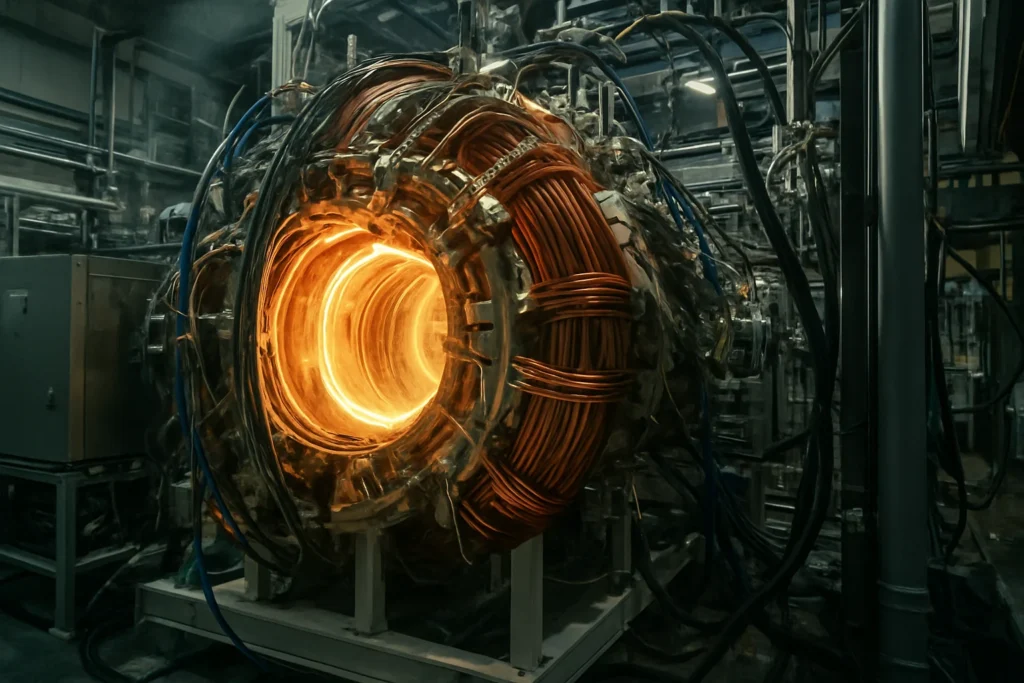For eons, humanity has looked to the stars with both a sense of wonder and profound envy. That distant, celestial fire has powered our planet, nurtured life, and guided our civilizations for billions of years. It’s the ultimate energy source, a testament to the immense, clean, and virtually limitless power that nuclear fusion can provide. For over seven decades, scientists and engineers have been engaged in an audacious quest to bring that very process down to Earth—to replicate the sun’s power in a controlled, sustainable manner. After decades of relentless struggle, false starts, and incremental victories, we have finally crossed the threshold into a new energy era.
The recent, monumental achievement of net energy gain in a fusion experiment is not merely a scientific breakthrough; it is a watershed moment that will be remembered as one of the most significant technological achievements of the 21st century. This wasn’t a stroke of luck but the culmination of centuries of physics discoveries, generations of engineering innovation, and the collective, indefatigable effort of thousands of researchers across the globe. It is a beacon of hope for a world grappling with the existential threats of climate change, the geopolitical instability fueled by a reliance on finite fossil fuels, and the moral imperative to provide clean, affordable energy to every corner of the planet. It is a tangible pathway to a future where energy is no longer a scarce commodity but an abundant resource, a future where we can finally unshackle ourselves from the chains of resource dependence and environmental degradation.
Understanding the Staggering Potential of Fusion
The Physics Behind the Power
Nuclear fusion operates on a principle so elegant and powerful it almost defies belief. At its heart, fusion is about overcoming the electromagnetic repulsion that naturally exists between positively charged atomic nuclei. By forcing these nuclei together with immense power, they overcome this barrier and merge, converting a small fraction of their mass directly into a colossal amount of energy. This process is a direct and spectacular demonstration of Albert Einstein’s most famous equation, E=mc2, where a minuscule amount of mass can unlock a universe of energy.
The most promising reaction for energy production on Earth involves two isotopes of hydrogen: deuterium and tritium. Deuterium is found in abundance in seawater, with just one gallon containing enough fusion fuel to power a home for centuries. Tritium, a rare isotope, can be bred directly within a fusion reactor using lithium, a widely available element. When these two nuclei fuse, they produce a helium nucleus and a single, high-energy neutron. It’s this neutron that carries the bulk of the released energy, which can be captured as heat to generate steam and turn turbines, just like in a traditional power plant.
Why Fusion Outshines All Other Energy Sources
The advantages of fusion power are so profound they sound almost fictional when compared to our current energy infrastructure.
- Fuel Abundance and Sustainability: The deuterium in one cubic kilometer of seawater contains fusion energy equivalent to all the world’s oil reserves combined. This makes fusion an effectively limitless energy source, a permanent solution to humanity’s energy needs.
- Environmental Safety: Fusion reactors produce no greenhouse gases and no long-lived radioactive waste. The only waste products are the reactor components themselves, which become mildly radioactive from neutron bombardment but only require a few decades of storage before their radioactivity drops to safe levels, a stark contrast to the thousands of years required for fission waste.
- Inherent Safety: Unlike a nuclear fission reactor, a fusion reactor cannot experience a meltdown. The reaction requires such precise and extreme conditions of temperature and pressure that if a system were to fail, the reaction would simply stop. There is no risk of a runaway chain reaction.
- Energy Density: Fusion boasts an astonishing energy density. One gram of fusion fuel has the potential to yield the same amount of energy as burning eight tons of oil, making it an incredibly efficient power source.
The Long Road to Breakthrough: A Story of Perseverance
Early Visionaries and the Birth of a Dream
The story of controlled fusion begins not in a laboratory, but with an idea conceived by British astrophysicist Sir Arthur Eddington in the 1920s. He was the first to propose that stars derive their immense energy from nuclear fusion, a revolutionary idea that laid the theoretical foundation for all future work. This was followed by the meticulous work of physicists like Hans Bethe, who detailed the specific nuclear reactions that power stars.
The first serious attempts to bring this cosmic power down to Earth began in the 1950s, amidst the intense secrecy and competition of the Cold War. Both the United States and the Soviet Union independently pursued fusion research, initially seeing it as a potential weapon before the transformative potential for peaceful energy production was fully realized. The year 1958 marked a critical turning point when fusion research was declassified, paving the way for international collaboration and accelerating the pace of discovery.
Decades of Frustration and Incremental Progress
The history of fusion research is a testament to human resilience, marked by alternating periods of great optimism and profound disappointment. Early predictions that fusion power was “just 30 years away” proved to be wildly optimistic, as researchers encountered one seemingly insurmountable technical challenge after another. The complex behavior of superheated plasma, the sheer engineering required to build and control these machines, and the need for new materials all contributed to a much longer timeline.
Key milestones in this journey included:
- 1968: Soviet physicists unveiled the tokamak design, a donut-shaped magnetic confinement device that demonstrated a dramatic improvement in plasma confinement, solidifying it as the dominant approach for decades.
- 1970s: Major national laboratories across the globe established long-term fusion programs, laying the groundwork for the large-scale experiments to come.
- 1990s: The construction of massive experimental reactors like the Joint European Torus (JET) and the Tokamak Fusion Test Reactor (TFTR) pushed the boundaries of what was possible, achieving groundbreaking results, though still falling short of net energy gain.
- 2000s: Private companies began to enter the fusion race, bringing new ideas, agility, and a sense of commercial urgency to a field traditionally dominated by government-funded research.
The Anatomy of a Fusion Reactor
Core Components and Cutting-Edge Technologies
Modern fusion reactors are among the most complex machines ever built, requiring an extraordinary integration of cutting-edge technologies from multiple scientific disciplines.
- Plasma Confinement Systems: This is the heart of a fusion reactor. It can be either magnetic (using powerful magnets to trap plasma) or inertial (using lasers or particle beams to compress and heat fuel).
- Superconducting Magnets: For magnetic confinement, this requires magnets capable of generating fields hundreds of thousands of times stronger than Earth’s magnetic field, pushing the boundaries of material science and cryogenics.
- Materials Engineering: The interior of a fusion reactor is one of the most hostile environments imaginable. Developing materials that can withstand the intense neutron bombardment and extreme heat for years on end is a critical and ongoing challenge.
- Fuel Cycle Systems: To be sustainable, a fusion reactor must not only produce energy but also breed its own tritium fuel from lithium, a complex process that requires sophisticated blanket designs and fuel extraction systems.
- Energy Conversion: Finally, the energy released from the fusion reaction must be efficiently converted into usable electricity, a challenge with different requirements depending on the type of fusion being pursued.
The Two Main Approaches to Controlled Fusion
The scientific community has pursued two primary pathways to controlled fusion, each with its own advantages and challenges.
Magnetic Confinement Fusion (MCF)
- How it works: This approach uses incredibly strong magnetic fields to confine and shape the superheated plasma, preventing it from touching the reactor walls.
- Leading Designs: The most common design is the tokamak, a donut-shaped vessel that has dominated research for decades. Another design, the stellarator, uses a more complex, twisted magnetic field to achieve better plasma stability.
- Key Projects: This approach is best exemplified by the ITER project in France, the largest scientific collaboration in history, and a newer, smaller reactor called SPARC being developed by a private company.
Inertial Confinement Fusion (ICF)
- How it works: This method uses powerful lasers or particle beams to compress a tiny fuel pellet to incredible densities and temperatures for a fleeting moment, igniting a mini-star at the center.
- Key Projects: This approach is championed by the National Ignition Facility (NIF) in California, the site of the recent breakthrough. The challenge now is to make this process repeatable and efficient.
The Breakthrough Moment: A New Chapter in Human History
December 2022: The Day the World Changed
The National Ignition Facility’s achievement of net energy gain on December 5, 2022, was a historic turning point. It proved beyond a shadow of a doubt that what was once a theoretical possibility is, in fact, an achievable reality. The experiment was a marvel of precision and power:
- Input: 2.05 megajoules of laser energy were delivered to a tiny, peppercorn-sized fuel capsule.
- Conditions: For a fleeting moment, the inside of the capsule reached a temperature hotter than the core of the Sun and a pressure billions of times that of Earth’s atmosphere.
- Output: The fusion reaction generated a stunning 3.15 megajoules of energy, a clear and undeniable net gain of over 50%.
- Significance: It was the first time in human history that any fusion experiment produced more energy than it consumed, proving the fundamental physics works as predicted and opening a new chapter in the pursuit of clean energy.
Why This Changes Everything
This breakthrough validated decades of research and billions of dollars in investment. It proved conclusively that net energy gain is achievable, moving fusion from a theoretical goal to a concrete engineering problem. The success has ignited a wave of optimism and a surge of new investment, particularly from the private sector, which now sees a clear path forward for commercialization.
Current State of Global Fusion Research: A Race Against Time
The world of fusion research has never been more vibrant, a unique blend of international collaboration and intense national and private-sector competition.
Major Government-Backed Projects
- ITER (International Thermonuclear Experimental Reactor): Located in Cadarache, France, ITER is a colossal $22 billion international collaboration involving 35 nations. Its goal is to demonstrate a sustained fusion reaction with a massive 500 MW output from a 50 MW input. Its first plasma is expected by 2025.
- China’s Fusion Program: China is rapidly emerging as a global leader in fusion research. Its EAST tokamak recently achieved a plasma temperature of 120 million degrees Celsius for over 100 seconds, and it has ambitious plans for its own commercial reactor, CFETR, a testament to its heavy investment in clean energy technology.
- U.S. Department of Energy Initiatives: The U.S. is strategically funding multiple approaches through its ARPA-E program and supporting public-private partnerships to accelerate development.
Private Sector Innovation: The New Frontier
The fusion landscape has been transformed by a new generation of well-funded private companies, bringing agility and a commercial mindset to the field.
- Commonwealth Fusion Systems (CFS): A spinout from MIT, CFS is developing a compact tokamak using a new type of high-temperature superconducting magnet. Their SPARC demonstration reactor aims to produce net energy gain by the mid-2020s.
- TAE Technologies: This company is pursuing a different, less-explored form of fusion called aneutronic fusion, which uses a proton-boron reaction that produces fewer neutrons.
- Helion Energy: Helion is developing a pulsed magnetic fusion device and has already signed a power purchase agreement with Microsoft, a clear sign of corporate confidence in the technology’s future.
Technical Challenges Remaining
While the net energy gain milestone was crucial, significant hurdles stand between today’s experiments and a functioning, cost-effective commercial power plant.
Plasma Stability and Control
A fusion reaction must be sustained, but maintaining the stability of a superheated plasma for extended periods remains a tremendous challenge. Turbulence and instabilities can cause the plasma to cool down or escape confinement, stopping the reaction.
Materials Science
The interior of a fusion reactor is one of the most hostile environments imaginable. The reactor components must withstand extreme heat fluxes and intense neutron bombardment from the fusion reaction itself. Developing materials that can survive these conditions for decades is a key area of ongoing research.
Tritium Breeding
Since tritium is not naturally abundant, future reactors must be able to breed their own supply from lithium. This requires a sophisticated “blanket” around the reactor core that captures the fusion neutrons and allows them to react with lithium to produce new tritium fuel.
Energy Conversion Efficiency
The final hurdle is converting the energy from the fusion reaction into usable electricity with high efficiency. This presents unique engineering challenges depending on the specific fusion approach and the type of energy carrier (e.g., heat or kinetic energy of charged particles).
The Road Ahead: A Plausible Timeline for Deployment
While predictions are notoriously difficult, a plausible roadmap to commercialization might look something like this:
- Near-Term Goals (2020s): Demonstrate repeated net energy gain, build a handful of pilot reactors, and test advanced superconducting magnets and tritium breeding concepts.
- Medium-Term Milestones (2030s): The first fusion pilot plants connect to power grids, regulatory frameworks are established, and a reliable supply chain for components begins to form.
- Long-Term Deployment (2040s+): The technology matures, costs decline through mass production, and fusion becomes a significant and growing part of the global energy mix.
Conclusion: A Transformative Moment for Humanity
The achievement of net energy gain in nuclear fusion is more than just a scientific triumph; it is a profound declaration of intent. It marks the beginning of humanity’s transition to an advanced energy civilization. While significant challenges remain, the fundamental physics has now been proven. The coming decades will see an unprecedented global effort to turn this laboratory success into practical power plants that could provide clean, abundant energy for centuries to come.
As we stand on the brink of this new era, we would do well to remember the words of fusion pioneer Lev Artsimovich: “Fusion will be ready when society needs it.” With climate change accelerating and global energy demand growing, that need has never been greater. The fusion age is dawning, and its light promises to illuminate a brighter future for all humankind.




2nf0im